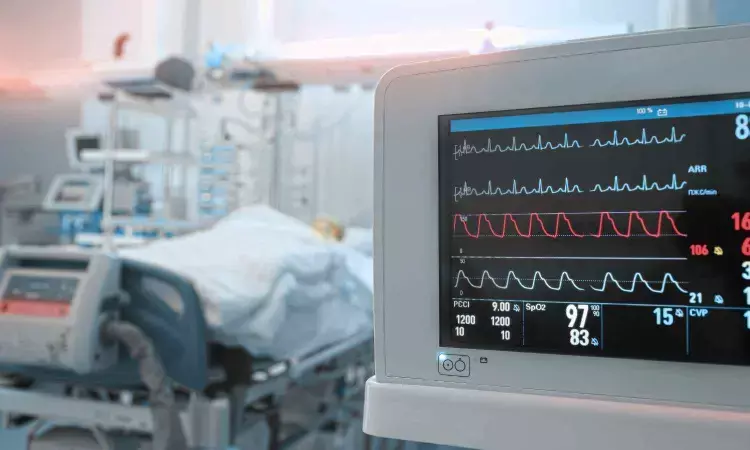- Home
- Medical news & Guidelines
- Anesthesiology
- Cardiology and CTVS
- Critical Care
- Dentistry
- Dermatology
- Diabetes and Endocrinology
- ENT
- Gastroenterology
- Medicine
- Nephrology
- Neurology
- Obstretics-Gynaecology
- Oncology
- Ophthalmology
- Orthopaedics
- Pediatrics-Neonatology
- Psychiatry
- Pulmonology
- Radiology
- Surgery
- Urology
- Laboratory Medicine
- Diet
- Nursing
- Paramedical
- Physiotherapy
- Health news
- Fact Check
- Bone Health Fact Check
- Brain Health Fact Check
- Cancer Related Fact Check
- Child Care Fact Check
- Dental and oral health fact check
- Diabetes and metabolic health fact check
- Diet and Nutrition Fact Check
- Eye and ENT Care Fact Check
- Fitness fact check
- Gut health fact check
- Heart health fact check
- Kidney health fact check
- Medical education fact check
- Men's health fact check
- Respiratory fact check
- Skin and hair care fact check
- Vaccine and Immunization fact check
- Women's health fact check
- AYUSH
- State News
- Andaman and Nicobar Islands
- Andhra Pradesh
- Arunachal Pradesh
- Assam
- Bihar
- Chandigarh
- Chattisgarh
- Dadra and Nagar Haveli
- Daman and Diu
- Delhi
- Goa
- Gujarat
- Haryana
- Himachal Pradesh
- Jammu & Kashmir
- Jharkhand
- Karnataka
- Kerala
- Ladakh
- Lakshadweep
- Madhya Pradesh
- Maharashtra
- Manipur
- Meghalaya
- Mizoram
- Nagaland
- Odisha
- Puducherry
- Punjab
- Rajasthan
- Sikkim
- Tamil Nadu
- Telangana
- Tripura
- Uttar Pradesh
- Uttrakhand
- West Bengal
- Medical Education
- Industry
Patients with ICU acquired Rapid Muscle Loss at increased risk of mortality, suggests study

State-of-the-Art Pediatric Modular OT Opens at Sishu Bhawan, Cuttack
A new study published in the Journal of Critical Care showed that individuals with ICU-acquired weakness (ICU-AW) exhibited comparable skeletal muscle mass upon ICU admission but a worse cellular nutritional status when compared to non-ICU-AW patients. Extensive muscular weakness that appears after admission to the intensive care unit is known as intensive care unit-acquired weakness. A poor prognosis is linked to the development of ICU-AW, which results in longer hospital stays, longer mechanical ventilation, and longer ICU stays.
The most recent developments in bioelectrical impedance analysis (BIA) offer a novel method for determining body composition and nutritional status. Since BIA is non-invasive, portable, affordable, and reproducible, it may be used with critically ill patients more readily than other nutritional evaluations. Prior research has documented correlations between BIA-derived indicators and outcomes in a number of illnesses, including malignant tumors, chronic obstructive pulmonary disease, and liver cirrhosis.
In order to assess the variations in body composition between patients with and without ICU-acquired weakness at the time of admission, Yoshito Yabe and his team carried out this study. It was anticipated that knowing the function of body composition prior to the emergence of ICU-AW would aid in the identification of possible treatment targets and enhance patient outcomes.
The mixed ICU at Tsukuba Memorial Hospital in Japan served as the site of this single-center, retrospective cohort research. The patients who were able to walk without assistance before admission, who underwent therapy after admission, and who lived for at least 48 hours were included in this study. During ICU admission, bioelectrical impedance analysis (BIA) was used to determine body composition. The characteristics, results, and body compositions of patients who were divided into ICU-AW and non-ICU-AW groups were compared.
28 (9.9%) of the 282 patients under analysis experienced ICU-AW. The SOFA ratings of ICU-AW patients were higher and they were older. In the ICU-AW group, BIA revealed a lower phase angle and a greater extracellular water to total body water ratio. The skeletal muscle mass was comparable between the groups. Overall, when compared to non-ICU-AW patients, the ICU-AW patients had relatively poor cellular nutritional status but comparable skeletal muscle mass at admission.
Source:
Yabe, Y., Komori, A., Iriyama, H., Ikezawa, K., & Abe, T. (2025). Association between the development of intensive care unit-acquired weakness and body composition at intensive care unit admission: A descriptive study. In Journal of Critical Care (Vol. 85, p. 154933). Elsevier BV. https://doi.org/10.1016/j.jcrc.2024.154933
Neuroscience Masters graduate
Jacinthlyn Sylvia, a Neuroscience Master's graduate from Chennai has worked extensively in deciphering the neurobiology of cognition and motor control in aging. She also has spread-out exposure to Neurosurgery from her Bachelor’s. She is currently involved in active Neuro-Oncology research. She is an upcoming neuroscientist with a fiery passion for writing. Her news cover at Medical Dialogues feature recent discoveries and updates from the healthcare and biomedical research fields. She can be reached at editorial@medicaldialogues.in
Dr Kamal Kant Kohli-MBBS, DTCD- a chest specialist with more than 30 years of practice and a flair for writing clinical articles, Dr Kamal Kant Kohli joined Medical Dialogues as a Chief Editor of Medical News. Besides writing articles, as an editor, he proofreads and verifies all the medical content published on Medical Dialogues including those coming from journals, studies,medical conferences,guidelines etc. Email: drkohli@medicaldialogues.in. Contact no. 011-43720751


